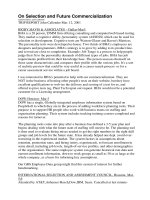Tài liệu Air Pollution and Environmental Chemistry pdf
Bạn đang xem bản rút gọn của tài liệu. Xem và tải ngay bản đầy đủ của tài liệu tại đây (827.8 KB, 58 trang )
451
Air Pollution and Environmental Chemistry
The facts:
Man-made emissions have contributed to two
conditions that are under close scrutiny by the scientific
community and the developed nations world–wide.
1. Global warming which is an increase in Green
House Gases
2. Ozone depletion in upper stratosphere
Q.
What is the public’s perception of the facts?
A.
Depends on which side of the political arena you are
on. Until very recently, partisan politicians have denied
and distorted the facts to John Q. Public.
Respect for science and its findings has been
diminished due to wishful thinking…
We all like to “hide our heads in the sand” sometimes,
but at what cost?
452
The Greenhouse Effect is the process in which the
emission of infrared radiation by the atmosphere warms a
planet's surface. The name comes from an incorrect analogy
with the warming of air inside a greenhouse compared to the
air outside the greenhouse. The greenhouse effect was
discovered by Joseph Fourier in 1824 and first investigated
quantitatively by Svante Arrhenius in 1896. The Earth's
average surface temperature of 14 °C (57 °F) would
otherwise be about -19 °C (-2.2 °F) in the absence of the
greenhouse effect. Global warming, a recent warming of the
Earth's lower atmosphere, is believed to be the result of an
enhanced greenhouse effect due to increased
concentrations of greenhouse gases in the atmosphere. In
addition to the Earth, Mars and Venus have greenhouse
effects.
The Earth receives energy from the Sun in the form of
radiation. Most of the energy is in visible wavelengths and in
infrared wavelengths that are near the visible range (often
called "near infrared"). The Earth reflects about 30% of the
incoming solar radiation. The remaining 70% is absorbed,
warming the land, atmosphere and oceans.
For the Earth's temperature to be in steady state so that the
Earth does not rapidly heat or cool, this absorbed solar
radiation must be very closely balanced by energy radiated
back to space in the infrared wavelengths. Since the
intensity of infrared radiation increases with increasing
temperature, one can think of the Earth's temperature as
being determined by the infrared flux needed to balance the
absorbed solar flux. The visible solar radiation mostly heats
the surface, not the atmosphere, whereas most of the
453
infrared radiation escaping to space is emitted from the
upper atmosphere, not the surface. The infrared photons
emitted by the surface are mostly absorbed in the
atmosphere by greenhouse gases and clouds and do not
escape directly to space.
The molecules/atoms that constitute the bulk of the
atmosphere: oxygen (O
2
), nitrogen (N
2
) and argon (Ar); do
not interact with infrared radiation significantly. While the
oxygen and nitrogen molecules can vibrate, because of their
symmetry these vibrations do not create any transient
charge separation. Without such a transient dipole moment,
they can neither absorb nor emit infrared radiation. In the
Earth’s atmosphere, the dominant infrared absorbing gases
are water vapor, carbon dioxide, and ozone (O
3
). The same
molecules are also the dominant infrared emitting molecules.
CO
2
and O
3
have "floppy" vibration motions whose quantum
states can be excited by collisions at energies encountered
in the atmosphere. For example, carbon dioxide is a linear
molecule, but it has an important vibrational mode in which
the molecule bends with the carbon in the middle moving
one way and the oxygens on the ends moving the other way,
creating some charge separation, a dipole moment, thus
carbon dioxide molecules can absorb IR radiation. Collisions
will immediately transfer this energy to heating the
surrounding gas. On the other hand, other CO
2
molecules
will be vibrationally excited by collisions. Roughly 5% of CO
2
molecules are vibrationally excited at room temperature and
it is this 5% that radiates. A substantial part of the
greenhouse effect due to carbon dioxide exists because this
vibration is easily excited by infrared radiation. (Wikipedia)
454
Panels/Groups convened over the last decades to
discuss environmental concerns
(1) IPCC Intergovernmental Panel on Climate change
“The Panel was established in 1988 through a
resolution of the UN General Assembly. One of its
clauses was significant in having stated, “Noting
with concern that the emerging evidence indicates
that continued growth in atmospheric
concentrations of “greenhouse” gases could
produce global warming with an eventual rise in
sea levels, the effects of which could be disastrous
for mankind if timely steps are not taken at all
levels. This means that almost two decades ago the
UN was acutely conscious of the possibility of
disaster consequent on climate change through
increases in sea levels. Today we know much more,
which provides greater substance to that concern.”
Speech by R K Pachauri, Chairman, IPCC
Oslo, 10 December 2007 in Acceptance of the Nobel
Peace Prize shared with Al Gore. Nobel citation: “for
their efforts to build up and disseminate greater knowledge about
man-made climate change, and to lay the foundations for the
measures that are needed to counteract such change".
455
IPCC is the Panel (established in 1988 through a
resolution of the UN General Assembly) that first
convened scientists from several industrialized nations
in the early 1990’s. The conclusion was that the
planet’s temperature would increase by 1.7 – 3.8˚C by
2100. The ultimate prediction is that the sea level
would rise between 15 and 90cm.
DISASTER!!
Up until the last IPCC report (Fourth Report) in 2007,
many politicians (and scientists) doubted the scientific
basis of global warming due to CO
2
emissions. The new
report put an end to all discussion. Prepared by
scientists all over the world, it placed the reality of
human-induced climate change beyond any doubt.
456
(2) Montreal Protocol
The Montreal Protocol on Substances that
Deplete the Ozone Layer is an international treaty
designed to protect the ozone layer by phasing out
the production of a number of substances believed
to be responsible for ozone depletion. The treaty
was opened for signature on September 16, 1987
and entered into force on January 1, 1989 followed
by a first meeting in Helsinki, May 1989. Since then,
it has undergone seven revisions, in 1990 (London),
1991 (Nairobi), 1992 (Copenhagen), 1993
(Bangkok), 1995 (Vienna), 1997 (Montreal), and
1999 (Beijing). Due to its widespread adoption and
implementation it has been hailed as an example of
exceptional international cooperation with Kofi
Annan quoted as saying it is "Perhaps the single
most successful international agreement to
date ".
[1]
(Wikipedia)
Kofi Atta Annan is a Ghanaian diplomat who served
as the seventh Secretary-General of the United
Nations from January 1, 1997 to January 1, 2007,
serving two five-year terms. Annan was the co-
recipient of the Nobel Peace Prize in 2001.
457
(3) Kyoto Climate Protocol
The Kyoto Protocol is a protocol to the international
Framework Convention on Climate Change with the
objective of reducing Greenhouse gases that cause climate
change.
It was agreed on 11 December 1997 at the 3rd Conference of
the Parties to the treaty when they met in Kyoto, and entered
into force on 16 February 2005 following ratification by
Russia. As of November 2007, 175 parties have ratified the
protocol. Of these, 36 developed countries (plus the EU as a
party in its own right) are required to reduce greenhouse gas
emissions to the levels specified for each of them in the
treaty (representing over 61.6% of emissions from Annex I
countries),
[1][2]
with three more countries intending to
participate.
[3]
One hundred and thirty-seven (137) developing
countries have ratified the protocol, including Brazil, China
and India, but have no obligation beyond monitoring and
reporting emissions. The United States has not ratified the
treaty. Among various experts, scientists and critics there is
some debate about the usefulness of the protocol, and there
have been cost-benefit studies performed on its usefulness.
(Wikioedia)
Target dates of Kyoto Protocol are:
458
The requirement is to comply from 2008-2012
The goal is to lower overall emissions of six
greenhouse gases – carbon dioxide, methane, nitrous
oxide, sulfur hexafluoride, hydroflurocarbons and
perfluorocarbons
Mandate of Kyoto Treaty is that industrialized countries
must reduce their collective emissions of greenhouse
gases in the 2008-2012 period by 5.2% compared to the
year 1990 levels. Bottom line: (Note that as compared
to the expected emission by 2010 without the Protocol,
this limitation represents about a 29% cut). The national
limitations range from 8% in the European Union, 7%
for the US, 6% for Japan, 0% for Russia, and permits
increeas of 8% for Australia and 10% for Iceland.
Problem is, many in the US think that is is placing
unrealistic demands on us to cut our emissions, such
that we will not ratify the treaty.
459
Q.
What can we do?
A.
Emissions trading among nations. In other words, an
industrialized nation that doesn’t want to reduce its
emissions could “buy” a permit from another
industrialized nation that would reduce its own
emissions less to account for the required decrease of
emissions.
460
United States Emissions
Kyoto target is not thought to be feasible for the U.S.
Grave economic consequences would ensure if we had
to cut back so much on fossil fuel burning.
461
Q.
What about alternative, cleaner fuels?
A.
Until very recently, the U.S. has invested very little
money in research based on solar conversion,
alternative fuel vehicles (main reason is that industry
has no incentive to “waste” money on such research – it
is more expensive technology than fossil fuel burning
technology). The attitude has changed recently,
however, as industry has been made to believe that
there is money to be made from green, “earth-friendly”
alternatives. hybrid cars etc.,
Clearly, the Kyoto Climate Treaty and resulting
Protocol is a good place to start, and, with time, it will
allow for implementation of goals. Time is running
out, though, if you listen to scientific forecasts.
Houston Air
- Houston Ship Channel in Texas
>100 large industrial manufacturing and chemical
plants / oil refineries
462
- Largest concentration of petrochemical companies
in the United States
- Population of Houston is > 4 million people so car
emissions are also enormous
Houston pollution is said to exceed the Los Angeles
metropolitan area.
Houston Air – Quality Study
$20 million dollars was spent in Aug – Sept 2000 to
gather data on air quality in Houston
• 300 researchers and over 40 public and private
institutions were involved in the project
• Six aircraft made daily sampling flights
1,500 – 2,500 feet mid-level
300 – 40,000 feet two extremes
to study vertical distribution of pollutants and ozone
precursor compounds
• Approx. 20 ground-based air quality stations in
eastern Texas measured chemicals with much more
sophisticated equipment than what is normally used.
100 organic compounds were detected
463
25 were monitored on a continuous basis including:
O
3
, SO
2
, NO
2
, NO
Biggest concern is O
3
in lower atmosphere for health of
Houston occupants. O
3
plume extends hundreds of
miles from Houston deep into Texas.
Clean air in Texas:
40 ppb O
3
clean air
>80 ppb O
3
stagnant air sometimes reaches
this level but often exceeds 80
120 ppb O
3
is considered to be limit of “safe
air”
Supreme Court wants to toughen standards to be less
than 120 ppb
Houston is sometimes 250 ppb which is way above the
level to damage lungs
Q. Where is O
3
coming from?
A. Normally it come from O atoms
464
O
2
→
hv
2O high energy ultraviolet
radiation in upper atmosphere
O + O
2
→ O
3
In lower atmosphere, free radicals such as Cl
∙
coming
from Cl
2
→
hv
2Cl
∙
(Houston uses a lot of Cl
2
in the chemical industry)
Cl
∙
+ O
2
→ C1O
∙
+ O
O
2
+ O → O
3
Also, car exhaust forms free radicals and O atoms
result.
Haze Particles
Blankets of tiny aerosol droplets coming from SO
2
that
turns into H
2
SO
4
droplets. This haze in the upper
atmosphere helps to offset global warming problems
due to its ability to reflect back more of the sun’s
radiation to outer space before it reaches the earth.
So one pollution problem actually helps alleviate
another pollution problem in this case!
465
Environmental Chemistry – An overview
A better understanding of environmental chemistry can
be obtained if it is viewed in perspective of global
energy needs and use, the consequences of such use and
the disposal of wastes and other products.
In this topic we present an overview of the subject, as it
pertains to this course, and consider the following
factors:
Energy uses
Disposal of chemicals and wastes
Toxicity of chemicals and wastes
Pollution of water, air and soil
Energy Needs – Use of Fuels
Our energy needs are presently being met by the
combustion of carbon-containing compounds and, to a
lesser extent, by nuclear fuels. The pollution problems
that result from such use are presented below. The
fossil fuels of concern to us are methane (CH
4
), gas, oil,
and coal.
466
I. The Greenhouse Effect
A. Natural Greenhouse Effect and Gases
The greenhouse effect is the term given to the natural
insulating effect of the earth’s atmosphere due primarily
to the presence of greenhouse gases that occur
naturally. Natural greenhouse gases are CO
2
, CH
4
and
N
2
O (nitrous oxide). Their presence is necessary, as
they help maintain the earth’s energy balance and keep
it from cooling down. Energy from the sun is
prevented from reaching the earth by many processes
including reflection from clouds and absorption by
clouds. In addition, the surface of the earth, as it cools,
radiates a great deal of the energy it has absorbed back
up into the atmosphere (called reradiation).
Fortunately, some of this reradiation is absorbed by
the carbon dioxide and water in the upper atmosphere
and subsequently radiated back to the surface of the
earth. In this way, additional heat is kept within the
lower atmosphere. This warming by absorption and
reeimission of radiation is a more technical
definition of the greenhouse effect.
467
B. Unnatural Sources of Greenhouse Gases –
Global Warming
As you know there is considerable concern about
enhancement of greenhouse effect. This concern stems
from the fact that there has been a huge increase in the
greenhouse gases from unnatural sources, mainly the
burning of fossil fuels. The atmosphere receives CO
2
from many sources including respiration of plants and
animals, forest fires and the burning of vegetable
matter. This CO
2
production is in delicate balance with
the uptake of CO
2
by plants for photosynthesis and by
the oceans that absorb CO
2
and precipitate it as MgCO
3
and CaCO
3
. After these natural uses of CO
2
, there is
only 5% left over. Most of this 5% comes from the
burning of coal and oil. If we continue to add more
CO
2
at the present rate, it is thought by some
that the surface of the earth may be warmed by several
degrees in the next 15 years. Even such a slight
warming would cause the polar ice caps to melt and
would cause other climatic changes.
468
Current Status of global warming in 2008
The issue of global warming by the excess CO
2
in the
atmosphere is no longer the hotly debated topic that it
was even several years ago. One alarming conclusion
came early on by the IPCC in 1992 that we would be
experiencing even more pronounced effects of global
warming if not for some cancellation of the accelerated
greenhouse effect by haze particles in the upper
atmosphere. Haze participles are large blankets of tiny
aerosol droplets that originate from volcanic eruptions
or from fuel burning that produces SO
2
that turns into
sulfuric acid droplets. This haze serves to reflect more
of the sun’s radiation back to space before it even
reaches the earth. The haze is not expected to be able
to compensate for the greenhouse effect over a period
of several decades, however.
Thus, according to these estimates, the continuing
combustion of fossil fuels may result in our reaching
the upper limit of CO
2
tolerance soon, and for this
reason some researchers suggest that alternate fuels,
such as nuclear, be used. Clearly, the greenhouse effect
is a serious problem worthy of constant monitoring.
469
II. Sulfur dioxide emissions
Oil and coal contain large amounts of sulfur.
Combustion of these fuels results in the emission of
sulfur dioxide into the atmosphere. The sulfur content
of an oil depends on its source. There are very few oils
that do not contain sulfur. Oil obtained from the North
Sea contains 1% S by weight. Oils from the Middle
East contain 4-5% sulfur. All sulfur in crude oil is
present as organic molecules, mostly thiophene, C
4
H
4
S.
Coal can contain several percent by sulfur weight,
depending on its source. The sulfur in the coal is
present both as organic sulfur and also in the form of
metal sulfides, such as FeS
2
. The sulfur in the oil
processed by an average refinery (100,000 barrels per
day) amounts to 713 million lbs. of SO
2
per year.
It should be realized that 80% of the SO
2
put into the
atmosphere in the United States comes from fuel
combustion (power plants) and it amounts to 26.5
million tons of SO
2
per year released into the
atmosphere. Furthermore, shale oil, a potential fuel for
future use, contains 2% N by weight which must be
removed prior to burning the fuel or otherwise nitrogen
470
oxides, which are both toxic and also produce acid
rain, would be released in the atmosphere.
III. Acid Rain
Acid Rain results from the reactions of SO
x
(SO
2
+
SO
3
) and NO
x
(NO + NO
2
) with water. Examples of
such acids are below:
SO
2
+ 2 H
2
O → H
3
O
+
+ HSO
3
-
(hydrogen sulfite)
HSO
3
-
+ H
2
O → H
3
O
+
+ SO
3
2-
(sulfite)
NO
2
+ 2 H
2
O → H
3
O
+
+ HNO
3
(nitric acid)
(HSO
3
-
and SO
3
2-
are related to H
2
SO
3
which is
sulfurous acid)
The acids thus produced are carried down from the
atmosphere to the soil during precipitation. It is
important to remember that acid rain will fall on areas
that are far removed from the location of the pollution.
This occurs because SO
x
and NO
x
form stable aerosols
in the atmosphere and thus move over the globe. An
aerosol is a relatively stable colloidal suspension of
gases, liquid and solids in air. When these settle, acid
rain is produced. Many lakes in the world are now
polluted because of acid rain. At a pH of 4.0 damage to
471
aquatic life occurs. The presence of CO
2
in water
cannot account for this acidity, as a pH 5.5 results upon
CO
2
saturation of a clean lake. Beginning in the early
1970’s, numerous lakes in the world have become too
acidic to support aquatic life.
The pollution of lakes, because of acid rain, appears
now to be more complicated than originally thought.
Some lakes have a pH of 4 but the aquatic life survives,
whereas in others it fails. This has now been attributed
to the presence of aluminum in the water which results
upon acidification of a lake. Aluminum collects in the
gills of fish and prevents them from breathing, thus
suffocation occurs. If the sediment of a lake is not rich
in aluminum-containing minerals, apparently no harm
is done.
472
IV. Combustion of Fossil Fuels
1. Methane
The combustion (total oxidation)given by the equation
CH
4
+ 2 O
2
→ 2H
2
O + CO
2
Is exothermic, ∆H = -192 kcal/mole, or 192 kcal of heat
released per 16g of fuel. Methane, found naturally, is
considered to be a clean fuel, its use contributing
primarily CO
2
to the atmosphere.
2. Coal
Coal is primarily a mixture of complex organic
compounds and consists by weight typically of 65% C,
5% H, 1% O and 10-12% water as moisture. Organic
and inorganic compounds containing sulfur are also
present. Furthermore, coal also contains hydrocarbon
compounds with nitrogen atoms. All of these will
produce both SO
2
and NO
2
upon combustion of the
coal. Thus, pollution prevention in this case could be
accomplished if SO
2
, SO
3
and NO
x
were “scrubbed
off” instead of released in the atmosphere. It would be
clearly uneconomical to remove S and N-containing
materials from coal prior to its combustion.
473
3. Oil
Oil combustion will also result in the formation of
oxides of sulfur and nitrogen. Their removal for
environmental reasons must also be achieved to prevent
SO
2
and NO
2
emissions.
V. Nuclear Fuels and Radioactive Compounds
A. Nuclear Fuels
Although nuclear fuels can be considered “clean” they
can cause even more serious problems than fossil fuels,
as they can release radioactive materials into the
environment; for this reason they are accepted only
reluctantly. However, the oil and coal supplies of the
world will dwindle with use and people will have to
depend on alternate fuel sources. Now let us compare
the energy release from heating gas or coal with that
released by nuclear fuels on a per mole or weight basis.
474
a. Energy released from Fission Reactions
92
U
235
+
0
n
1
→
56
Ba
141
+
36
Kr
42
+ 3
0
η
1
+ 200 Mev/atom
Per mole, the energy released is 2.76 x 10
27
kcal/mole
0
n
1
= (neutron)
b. Energy released from Fusion Reactions
1
H
2
+
1
H
3
→
2
He
4
+
0
n
1
+ 17.6 Mev/atom
1
H
2
is deuterium (D);
1
H
3
is tritium (T)
Per mole, the energy released is 2.3 x 10
32
kcal/mole
Clearly, nuclear reactions are unlike chemical reactions.
The aforementioned fission reaction served as the basis
for the first atomic bomb exploded in 1945.
In comparison, one mole of methane releases only 192
kcal/mole, thus the fusion reaction on a per mole basis
releases 10
30
times more energy. The advantage of the
nuclear fuels is thus very obvious.
The problem presented by the nuclear fuels are:
- leakage of radioactive species from nuclear reactors
- potential for malignancies due to such radioactivity
- difficulty in disposing of nuclear wastes
475
B. Radioactive Compounds in Medical Applications:
Although radioactive isotopes can cause the problems
outlined above, their beneficial effects in therapy and
medical diagnosis should be kept in mind. Some of
these are given below.
Isotope Form Employed Treatment or Diagnsis
Co
60
metallic cobalt (Co) treatment of tumors
Cu
64
copper acetate brain scans for tumors
(Cu
2
(O
2
CCH
3
)
4
)
I
131
sodium iodide (NaI) hyperthyroidism
Tc
99
sodium pertechnetate brain and tumor scans
(NaTcO
4
)









